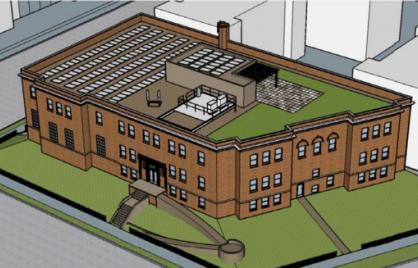
Washington City Paper by Jeanine Santucci
If a new project slated for underutilized public land in Hill East is any indication, shared living spaces aren’t just for busy millennials who want to enjoy hipster-branded amenities with friends.
This week, the District announced its selection of a development proposal centered on “senior co-housing” for the former Eastern Branch Boys and Girls Club building at 261 17th St. SE.
The team of Century Associates, Eco Housing Corp., and Keystar Real Estate will redevelop the 11,000-square-foot site into 29 “independent living” units and a publicly accessible community space, according to Deputy Mayor for Planning and Economic Development Brian Kenner.
The club closed in 2007 and D.C. purchased the site in 2010 for $20 million. DMPED’s decision comes after it revealed two redevelopment possibilities for the site about a month ago. Although the site was initially up for redevelopment in 2014, the District’s planning process hit roadblocks when community members voiced concerns, including about the length of a prospective lease.
Now, the developers’ vision for the project involves for-sale instead of rental housing. Ten of the units will be priced at affordable levels and set aside for those whose incomes are up to 50 or 80 percent of D.C.’s area median income (or about $55,000 and $88,000 a year for a family of four, currently).
All the units will either be one- or two-bedrooms. A proposed two units will be designated for caregivers. The shared spaces will feature amenities for cooking and dining, lounging with television, and leisure activities, the development team explains. Additionally, the character of the three-story building’s exterior will be preserved, and the site will be upgraded with solar panels and a green roof.
Senior co-housing isn’t a new idea, but it’s gaining in popularity. The developers point to existing facilities in the area like Takoma Village Cohousing and Eastern Village Cohousing as ones that provide similar living models.
This proposal partially markets itself as a novel twist on the age-old notion of having roommates, just as co-housing developments geared toward younger populations often do. Features cited by the team include the “health benefits of social interaction,” the participation of all residents in making decisions, and the retention of older community members who might otherwise move away.
DMPED picked the winning proposal over another that focused on family-sized apartments. In November, the local advisory neighborhood commission, ANC 6B, voted to support the senior co-housing bid, in part for being more in line with D.C.’s Comprehensive Plan, Hill Rag reported.
“This is a big win for Ward 6 and our neighbors,” says D.C. Councilmember Charles Allen in a statement. Allen notes that he had asked Mayor Muriel Bowser’s administration to restart the planning process for the site in 2015 after hearing the community's needs. Kenner, the deputy mayor, notes DMPED solicited input from neighbors through a special initiative called OurRFP.
The specific terms of the agreement must be finalized before the D.C. Council votes on it. The community space planned for the project is expected to be 1,850 square feet and programmed with neighbors’ feedback.


